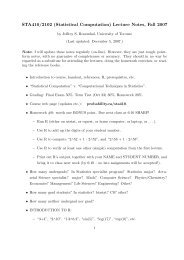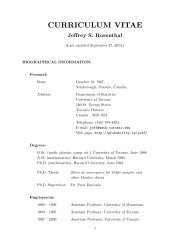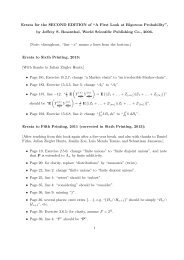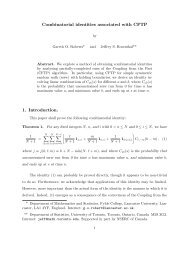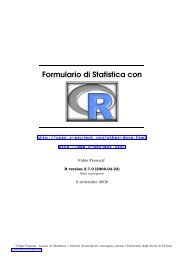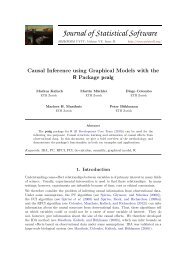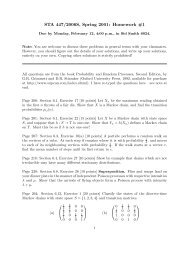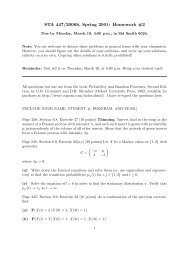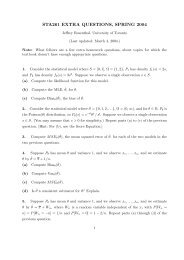final report - probability.ca
final report - probability.ca
final report - probability.ca
You also want an ePaper? Increase the reach of your titles
YUMPU automatically turns print PDFs into web optimized ePapers that Google loves.
ˆ By using closeness of drift function (3.13) with µ (x), and z N<br />
Ŵ N ⇒ W as N → ∞ such that<br />
with ¯z N , it follows there exists a process<br />
)<br />
so z N = Θ<br />
(x 0,N , Ŵ N .<br />
z N (t) = x 0,N + h (l)<br />
ˆ t<br />
0<br />
µ ( z N (u) ) du + √ 2h (l)Ŵ N (t) ,<br />
)<br />
– Since Θ is continuous, it follows z N = Θ<br />
(x 0,N , Ŵ N ⇒ Θ ( z 0 , W ) = z as N → ∞.<br />
A<br />
Infinite Dimensional Analysis<br />
A.1 Introduction<br />
There is no natural analogue of the Lebesgue measure on an infinite dimensional Hilbert space. A natural substitute<br />
is provided by Gaussian measures. The theory expounded in these notes define Gaussian measures on a finite<br />
dimensional space, and then through an infinite product of measures, on the infinite dimensional Hilbert space H,<br />
assumed to be separable.<br />
Later we talk about the Cameron-Martin formula, which is an important tool discussing absolute continuity and<br />
singularity of a Gaussian measure and its translates.<br />
We consider first Gaussian measure on (H, B (H)), where H is a real separable Hilbert space with inner product<br />
〈·, ·〉 and norm ‖·‖, and B (H) is the Borel sigma algebra on H. Let L (H) denote the Banach algebra of all continuous<br />
linear operators on H, L + (H) denote the set of all T ∈ L (H) that are symmetric (〈T x, y〉 = 〈x, T y〉 , ∀x, y ∈ H)<br />
and positive (〈T x, x〉 ≥ 0, ∀x ∈ H), and <strong>final</strong>ly L + 1 (H) the set of all operators Q ∈ L+ (H) of trace class, i.e.,<br />
operators Q such that trace (Q) := ∑ k≥1 〈Qe k, e k 〉 < ∞ for all complete orthonormal systems {e k } k≥1<br />
∈ H.<br />
A.1.1<br />
Infinitely Divisible Laws<br />
The law of a random variable X is the <strong>probability</strong> measure X # P on (E, B (E)) defined as<br />
X # P (I) = P ( X −1 (I) ) = P (X ∈ I) , I ∈ B (E) .<br />
The convolution ν 1 ⋆ ν 2 of two finite Borel measures ν 1 and ν 2 on R N is given by<br />
ν 1 ⋆ ν 2 (Γ) =<br />
ˆR N ˆ<br />
R N I Γ (x + y) ν 1 (dx) (dy) , Γ ∈ B R N ,<br />
and the distribution of the sum of two independent random variables is the convolution of their distributions. We<br />
want to describe the <strong>probability</strong> measure µ that, for each n ≥ 1, <strong>ca</strong>n be written as the n-fold convolution power<br />
µ ⋆n 1 of some <strong>probability</strong> measure µ 1 .<br />
n<br />
n<br />
Re<strong>ca</strong>ll that the Fourier transform takes convolution into ordinary multipli<strong>ca</strong>tion, the Fourier formulation for<br />
infinite divisibility involves describing those Borel <strong>probability</strong> measures on R N whose Fourier transform ˆµ has, for<br />
each n ∈ Z + , an n th root which is again the Fourier transform of a Borel <strong>probability</strong> measure on R N .<br />
A.2 Gaussian Measures in Hilbert Spaces<br />
A.2.1<br />
One-dimensional Hilbert spaces<br />
Let us first consider the well-known <strong>ca</strong>se where H is a one-dimensional Hilbert space. Consider (a, λ) ∈ R 2 with<br />
a ∈ R and λ ∈ R + . We define a <strong>probability</strong> measure N a,λ in (R, B (R)) as follows. If λ = 0, we set<br />
where δ a is the Dirac measure at a,<br />
N a,0 = δ a ,<br />
δ a (B) = I {a∈B} ,<br />
for B ∈ B (R). This is a degenerate Gaussian measure, and is not of much use to us for our appli<strong>ca</strong>tions.<br />
34



